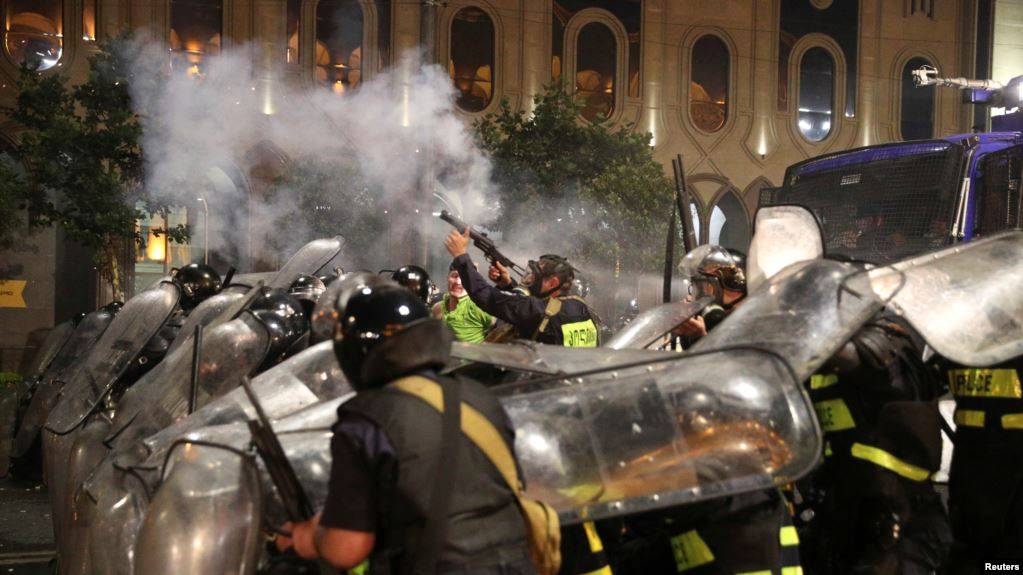საერთო ცხელი ხაზი +995 577 07 05 63


With this Report, the EMC provides the initial legal assessment of the 20 June events and at the time being, is based on the information accessible for the organization. Obviously, after more detailed analyses, human rights violations practices and individual cases will reach a larger scale and hence, will require more detailed and in-depth analyses. As of today, considering the materials at hand and limited methodological instruments for analyses, the EMC considers that on 20 June, the behavior of the part of the protestors on Rustaveli Avenue gained uncontrolled violent character and gave to the police the legal ground for interfering with freedom of assembly and dispersal. However, during dispersal, the police disregarded legal requirement prescribed for dispersal and failed to utilize negotiation recourses. Without having any effective, reasonable and thorough plan to manage the human masses, the police used excessive force massively and without differentiation, clearly violating the sequence and rules for use of special means and as a consequence, severely injured demonstrators and in some cases, caused irreparable injuries. After the first dispersal of the rally, at midnight, the police actions clearly became arbitrary. At this point, it became vague as to what was the legitimate objective for chasing, arresting and abusing those standing afar from the Parliament building for several hours.
The scale and intensity of the police abusive force, lack of systems for effective monitoring and prevention of the clear and massive violation of the human rights by the police, and continuing tolerance of these processes for several hours, clearly calls for legal and political responsibilities of relevant high-ranking and decision-making officials at the Ministry of Interior Affairs.
The Report provides a detailed description of the dynamics of the development of the demonstration, including, the rally participants’ attempts and objectives to storm the Parliament building, episodes of the attack on the police cordon in front of the Parliament building. This very repeated aggressive behavior and recurring attempts to break into the Parliament yard gave to the police a legal ground to disperse the demonstration. It is unfortunate that opposition political leaders too were engaging in such illegal encouragement. Even more so, in light of the escalated situation, the organizers of the rally did not even try to stop the violent behavior of the participants and take steps towards de-escalation. Running of the democratic processes with such tactics inherently contradicts the idea of democracy and such irresponsibility calls for an appropriate legal and political evaluation.
Despite the legality of the decision on the dispersal of the rally, the consecutive police actions revealed a number of problematic, and among them, severe episodes. First of all, the police - in clear violation of the legislation regulating the assemblies and manifestations, failed to ensure proper warning of the participants prior to the dispersal.
The police launched dispersal at midnight by firing tear gas. Shortly, even though the recourses of the less intensive and severe special means were yet not been exhausted, tear gas was followed by the rubber bullets. Moreover, the threat, feasibility and imminence of repeated attempt to storm the Parliament building and/or attack the police units after tear gas was not adequately assessed.
Dispersal operation practically lasted the whole night. A certain part of the protestors exposed aggressive behavior towards the police in various locations, by using different objects. However, the police failed to separate peaceful rally participants from the violent ones and the intense police force was applied without differentiation. This is most clearly confirmed by the dozens of injured journalists. Use of special means by the police caused severe injuries to the protestors. In some cases, the police fired rubber bullets from a close distance targeting the head and face, hence increasing the severity of the injuries. In the process of enforcement of the decision on dispersing the rally, the police failed to comply with the rules and sequence pertaining to the use of special means and used disproportionate force.
Dispersal of the rally was followed by arrests of dozens of protestors. Grounds for arrests and clarifications of the police personnel provided to the court are weak, hackneyed and extremely identical. In a number of cases, it indicates that the arrests were arbitrary. The information on physical abuse by the police during as well as after arrest is especially alarming. Part of the detainees pointed out that they were beaten, subjected to inhuman treatment and mistreated after being arrested.
The anti-occupation rally of the 20th of June, which later turned into the violence, was dispersed by the disproportional police force. Despite the legitimate grounds for the dispersal, in the process of planning and execution, the police violated various aspects of fundamental freedoms such as: freedom of assembly and manifestation, freedom and physical immunity, and prohibition of inhuman treatment. By all means, the harshly aggressive behavior of the part of the participants and episodes of clashes with police is to be taken into consideration. However, it is clear that in the process of dispersal, the police failed to uphold the principle of differentiation and proportionality.
The dispersal of the 20 June rally also emphasized the institutional challenges, namely that the Ministry of Internal Affairs lacks enough strategy, technics, systems and human resources to manage mass gatherings in compliance with the human rights standards.
The systems necessary for formulating a reasonable and efficient action plan, measuring and preventing threats, monitoring, checking and harmonizing the processes are still fragile, faulty and weak. Engagement of the personnel of the Ministry of Internal Affairs in the violence of this scale against its own citizens substantially damages the trust towards law enforcement agencies. June 20 was a continuation of the severe political and social experience concerning coercive dispersal of the demonstrations that took place in previous years (including 7 November 2007, 26 May 2011). It is indicative of the practice of institutional violence and weakens the confidence into the state institutions and democratic processes.
In order to react properly to the plain violation of human rights, and more generally to the recurring, long-lasting and severe illegalities demonstrated by the police actions, the below listed is of utmost importance:
The website accessibility instruction